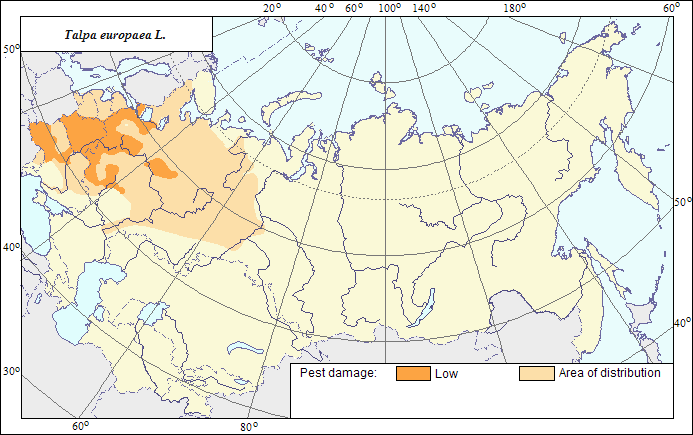Pests
Area of distribution and pest damage of Talpa europaea L.
 Object description Download GIS-layers
Object description Download GIS-layers
Authors:
Object specialist - M.I.Saulich ,GIS-specialist - M.I.Saulich.
Date of creation:
11.03.2008.Scale:
1:20 000 000.Accuracy of map:
It is created on information taken from the open published literature and maps of scale 1:30-40 000 000; 1; 70-110 000 000; 1: 436 000 00Projection:
"Alber's Equal Area Conic for the USSR", 9, 1001, 7, 100, 0, 44, 68, 0, 0.Basic content:
Vector map consisting of 2 layers. Area and zone of damage are shown by polygons.Accuracy of the classifier:
The point scale developed by Mironov et al. (1989) is based on pest damage zone allocation. The damage zone is defined in areas where moles occupy agricultural lands by 3-4 points. Third point corresponds with penetration of the moles deeply into fields from the constant colonies located along its periphery. Forth point is characterized by indiscernible separate groupings of soil hills; i.e., field occupation has continuous character.Method of map production:
At delimitation of the area, a number of maps from publications of Bobrinskii et al. (1965), Flint et al. (1970), Pavlinov et al. (2002) and Hutchins M. et al. (2003) have been used. In addition, the data from text descriptions (Gromov et al., 1963; Stroganov, 1957; Mironov et al., 1989; Kononov, 1990; Lisenkov, 2000) have been widely applied. In the forest and forest-steppe zones, the European Mole is distributed from the western frontiers of the former USSR to Trans-Ural, including the western and northern administrative districts of Tyumen Region. The species does not live in steppes, though getting far southward along fluvial valleys. In the North this species goes to the White Sea coast and eastward along the northern forest zone border. In Siberia, the distribution area adjoins to the area of the Siberian Mole (Talpa altaica). The zone of low damage covers western Ukraine, Belarus and some Russian areas of Non-Chernozem and Chernozem regions.Reference citations:
Bobrinskii N.A., Kuznetsov B.A., Kuzyakin A.P. 1965. Keys to Mammals of the USSR. Moscow: Prosveshchenie, 382 p. (in Russian).Flint V.E., Chugunov Yu.D., Smirin V.M. 1970. Mammals of the USSR. Moscow: Mysl., 437 p. (in Russian).
Gromov I.M., Gureev A.A., Novikov G.A., Sokolov I.I., Strelkov P.P., Chapskii K.K. 1963. Mammals of the USSR fauna. Part 2. In: Pavlovskii E.I., ed. Moscow, Leningrad: Izdatel.stvo Akademii Nauk SSSR, 639 p. (in Russian).
Hutchins M., Kleiman D.G., Geist V., and McDade M.C. eds. 2003. Grzimek.s Animal Life Encyclopedia, 2nd edition. Vol. 13, Mammals II. Detroit et al.: Farmington Hills, MI: Gale Group, 580 p.
Kononov S.I. 1990. Prospects of moleskins purchasing in BSSR. In: Proceedings of V All-Union Teriological Society of AN SSSR. V.3. Moscow, p. 99 (in Russian).
Lisenkov Yu.M. 2000. Ecology, distribution and resources of the European Mole in Vyatka region. PhD Thesis. Kirov: The All-Russia Zhitkov scientific research institute of the hunting economy and fur farming, 21 p. (in Russian).
Mironov A.D., Bublichenko A.G., Verevkin M.V., Gerasimov S.V. 1989. Report on the research work: Development of recommendations to prevent harmful activity of the European Mole in agrocenoses. Leningrad, 77 p. (in Russian).
Pavlinov I.Ya., Kruskop S.V., Varshavskii A.A. & Borisenko A.V. 2002. Land animals of Russia. In: E.A.Dunaev & K.G.Mikhailov, eds. Manual-Identification book. Moscow: KMK. 298 p. (in Russian).
Stroganov S.U. 1957. Siberian beasts. The insectivorous. Moscow: Izdatelstvo Akademii Nauk SSSR, 268 p. (in Russian).

